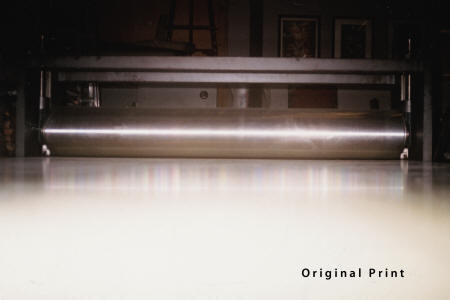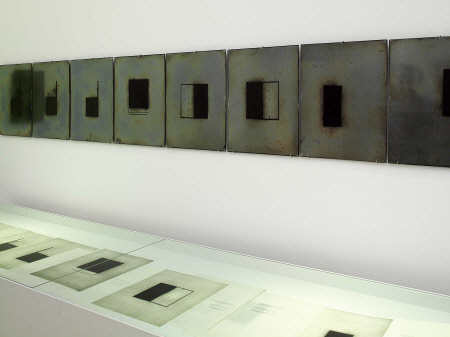Original Print

In around twenty years of work and investigation together with the printer Giorgio Upiglio, Roberto Ciaccio has blazed an innovative trail using the original print and its tools in a continuous metalinguistic reflection. The variety and exceptional nature of the techniques (aquatint, monotype, monoprint) and the creation of large works/matrices on metal plates (iron, zinc, copper) has allowed him to produce a corpus of works characterized by a wholly original thought in its numerous conceptual and practical aspects, resulting in new stylistic and expressive possibilities.
Ciaccio’s work gives rise to a redefinition of the very concept of ‘original’ and of the processes of serial production and the technical reproducibility of the original print.
Paradoxically, in the spiritual dimension of his output, the auratic nature of the work is intensified precisely where the tools of technical reproducibility — as Walter Benjamin saw them — seem to negate it. The vision of the work is driven towards uniqueness and technical irreproducibility.
Seriality is, in fact, reconsidered, starting from the unicum of his monoprints that give rise to the continuum of a coming into being of the difference (or différance in Jacques Derrida’s sense, which is also temporal), although originating from the identity of a single matrix.
Moreover, it is in connection with the serial sequences and the intervallic rhythms of his works — various metal plates and large monoprints — characterized by what Jacques Derrida called différance, that the relationship with the architectural space takes place in the becoming into being of the image.
In addition to the original editions, monoprints and monotypes, the exhibitions also include large plates of different metals (copper, zinc, iron), which, with their specific materials, dimensions, weight and brightness, become matrices and works in their own right.
‘Like all
the great European art from its origins, Roberto Ciaccio’s art is open
to various interpretations: a more ancient layer is formed by the symbol
and the sacred; then the experience of time, which is preserved and is
visible in the work of art; in addition, the importance of the modern
theories of the media and the image, from Walter Benjamin to Jacques
Derrida, and the theory of deconstructionism, as well as of aesthetic
difference; lastly, there is also the conceptual interpretation, the
interpretation of the experimental disposition, the deletion of the
individual — a minimalist variation, as it were….’ - Hein-Th.
Schulze Altcappenberg, director of the Kupferstichkabinett, Berlin.
|
Roberto Ciaccio. A Metalanguage of the Original Print |
|
The broad range of experience and the originality of their work together consists of various cycles of works executed with innovative methods (many of them technical) which reveal a coherent, unitary course of expression and reflection on the specific nature of the language itself and on the instruments employed. Thus Roberto Ciaccio’s work becomes a real metalanguage of the original print.
Roberto Ciaccio’s expression of the contents of thought in his works involves constant reflection and meditation on the constituent, founding elements of original printmaking language and addresses certain essential problems and dimensions of that language in a suggestive, yet systematic way, as, for instance:
- The intense, harmonious spiritual and technical feeling between artist and printmaker. - The mirroring plate/sheet - matrix/figure relationship, also viewed in terms of its paradoxical conceptual and technical reversibility (the plates in Roberto Ciaccio’s work, above and beyond their technical functionality, consist of the specific nature of their own presence and of their own independent expressivity and identity). - The relationship between artwork and origin according to Heidegger’s thought in Holzwege (“Der Ursprung des Kunstwerkes”). - The concept of "aura" explored and redefined in relation to the serial nature and instruments of original printmaking (with Walter Benjamin’s The Work of Art in the Age of Mechanical Reproduction as the point of departure); the intensification of the aura’s presence in Ciaccio’s printed work which intentionally orients his artwork towards an uniqueness, an impossibility for being repeated or technically reproduced. - A new way of considering seriality, starting from the idea of an unicum and heading towards the idea of “différance” (as intended by Jacques Derrida). - The continuum of differences lasting throughout the creation of an image over time intensely expresses the condition of a figure in terms of its identity/difference or its difference/repetition, despite the identity of its matrix (Gilles Deleuze). - The essential nature of a trace as a mirroring reference mark as regards a presence/absence relationship. - The problems linked to processes which lead to the “idea of image” or to the “absence of image”. - The essential ambiguity of the presence/absence relationship is entrusted to a coherent work path whose dimension is the light/darkness relationship.
The particular strength of Roberto Ciaccio’s work, including its philosophic force, has already decidedly involved many important philosophers in the past, such as Remo Bodei, Jacques Derrida, Mario Perniola, Arturo Schwarz and others, who have concentrated on his work at conferences, seminars and round-table discussions. Roberto Ciaccio’s work involves a theoretic and philosophical in-depth exploration of the contemporary problems regarding images and the processes of original print-making related to current technologies.
Kupferstichkabinett Staatliche Museen zu Berlin 2006 Istituto Nazionale per la Grafica Roma 2008/09
|
